M522 Finance & Risk Management: Stock Analysis of LG & Samsung
VerifiedAdded on 2023/06/04
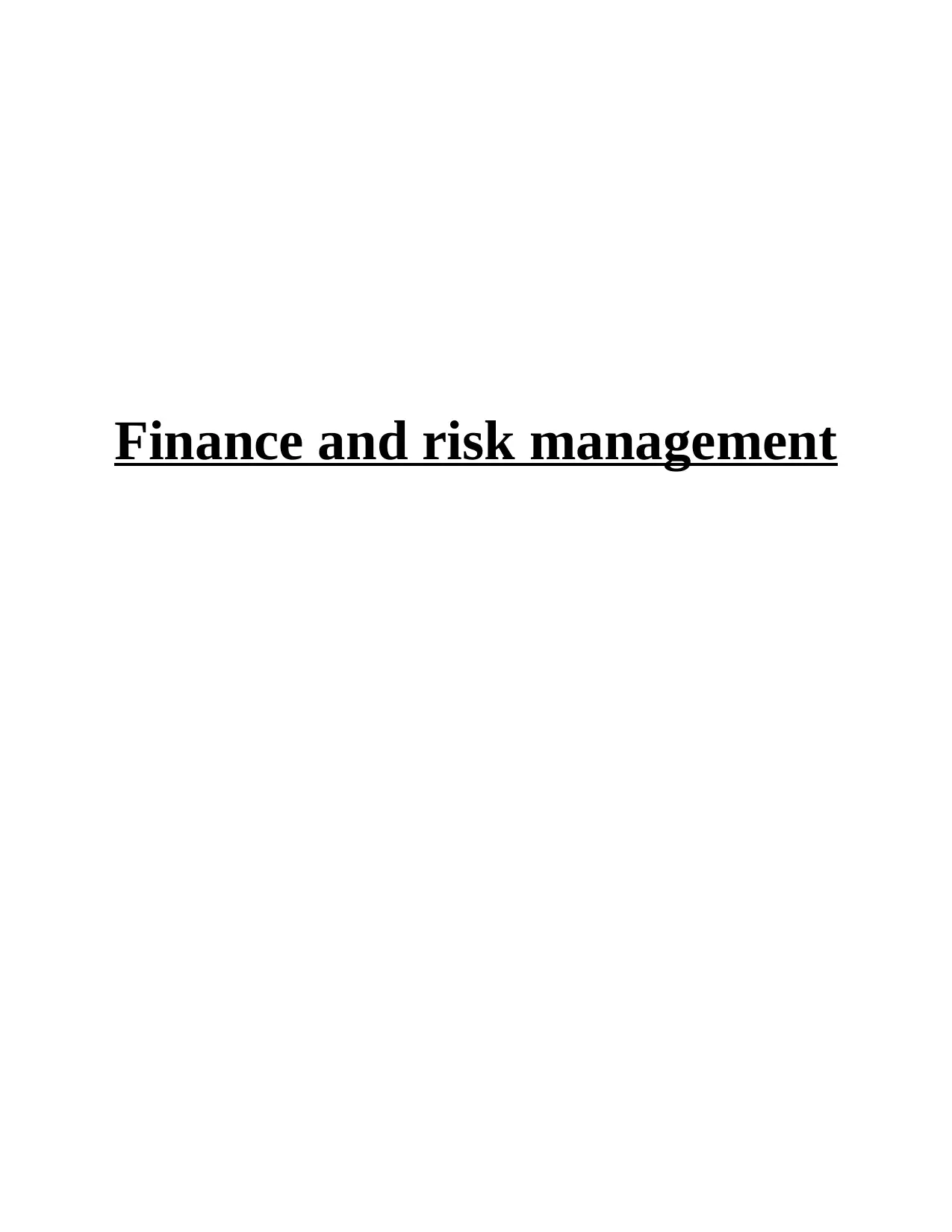
Paraphrase This Document
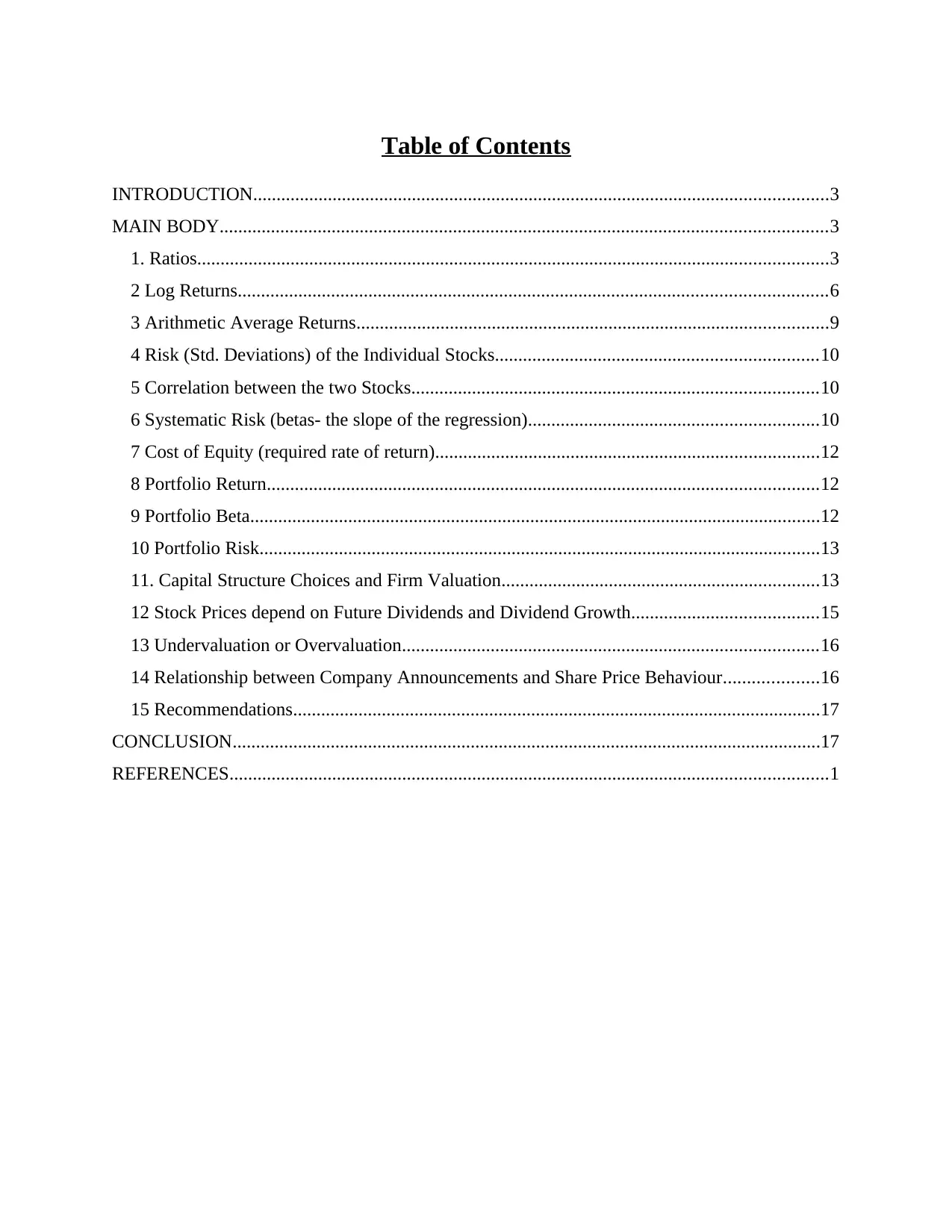
INTRODUCTION...........................................................................................................................3
MAIN BODY..................................................................................................................................3
1. Ratios.......................................................................................................................................3
2 Log Returns..............................................................................................................................6
3 Arithmetic Average Returns.....................................................................................................9
4 Risk (Std. Deviations) of the Individual Stocks.....................................................................10
5 Correlation between the two Stocks.......................................................................................10
6 Systematic Risk (betas- the slope of the regression)..............................................................10
7 Cost of Equity (required rate of return)..................................................................................12
8 Portfolio Return......................................................................................................................12
9 Portfolio Beta..........................................................................................................................12
10 Portfolio Risk........................................................................................................................13
11. Capital Structure Choices and Firm Valuation....................................................................13
12 Stock Prices depend on Future Dividends and Dividend Growth........................................15
13 Undervaluation or Overvaluation.........................................................................................16
14 Relationship between Company Announcements and Share Price Behaviour....................16
15 Recommendations.................................................................................................................17
CONCLUSION..............................................................................................................................17
REFERENCES................................................................................................................................1
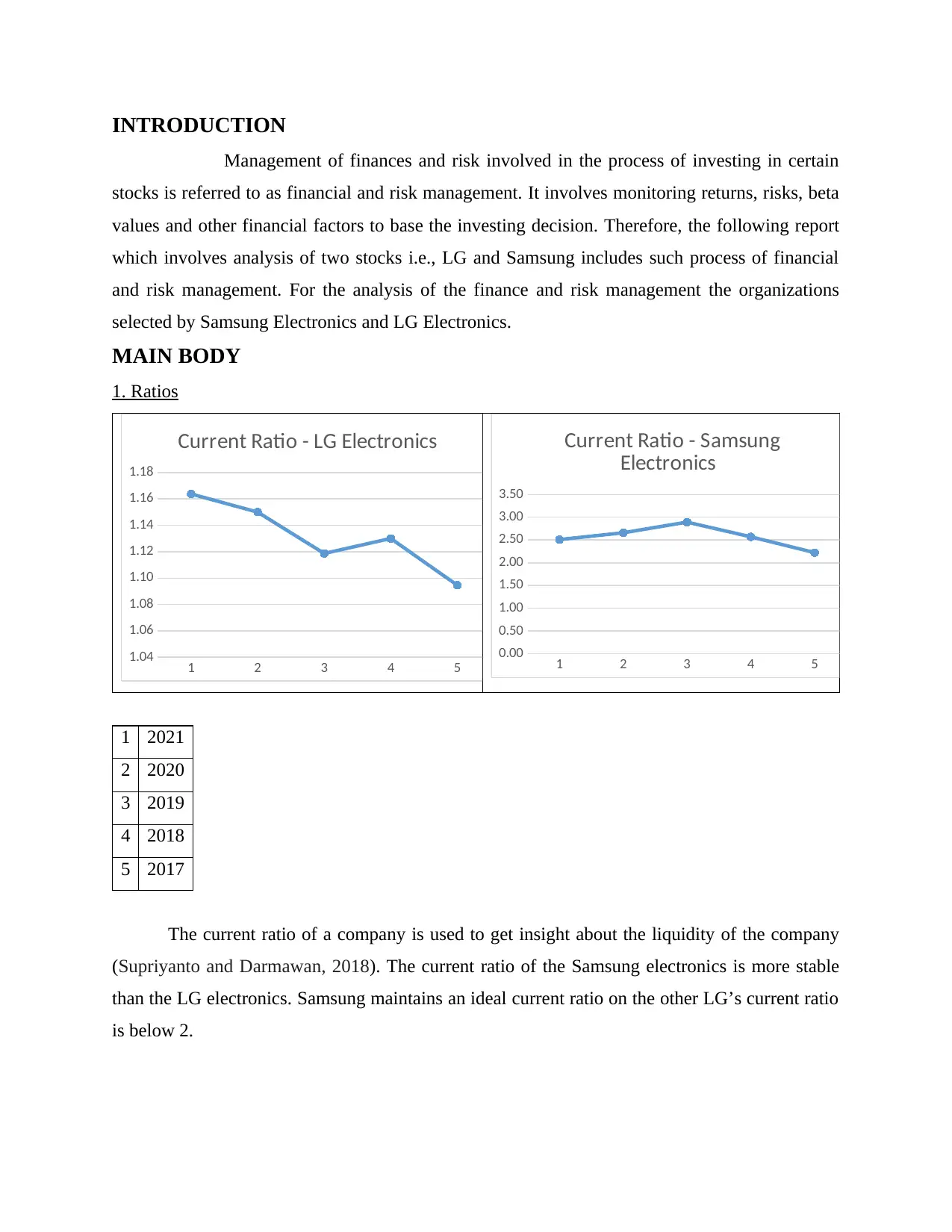
Management of finances and risk involved in the process of investing in certain
stocks is referred to as financial and risk management. It involves monitoring returns, risks, beta
values and other financial factors to base the investing decision. Therefore, the following report
which involves analysis of two stocks i.e., LG and Samsung includes such process of financial
and risk management. For the analysis of the finance and risk management the organizations
selected by Samsung Electronics and LG Electronics.
MAIN BODY
1. Ratios
1 2 3 4 5
1.04
1.06
1.08
1.10
1.12
1.14
1.16
1.18
Current Ratio - LG Electronics
1 2 3 4 5
0.00
0.50
1.00
1.50
2.00
2.50
3.00
3.50
Current Ratio - Samsung
Electronics
1 2021
2 2020
3 2019
4 2018
5 2017
The current ratio of a company is used to get insight about the liquidity of the company
(Supriyanto and Darmawan, 2018). The current ratio of the Samsung electronics is more stable
than the LG electronics. Samsung maintains an ideal current ratio on the other LG’s current ratio
is below 2.
⊘ This is a preview!⊘
Do you want full access?
Subscribe today to unlock all pages.

Trusted by 1+ million students worldwide

0.73
0.74
0.75
0.76
0.77
0.78
0.79
Quick Ratio - LG Electronics
1 2 3 4 5
0.00
0.50
1.00
1.50
2.00
2.50
3.00
Quick Ratio - Samsung
Electronics
Quick ratio also depicts the liquidity position of the company. A quick ratio of 1 is
considered to be an ideal ratio. LG is having a ratio below the standard level for all the five
years. Samsung maintains its ratio above the standard requirement, which is also not good. The
results show that Samsung is more capable to pay more its current obligations.
1 2 3 4 5
0.00%
1.00%
2.00%
3.00%
4.00%
5.00%
Return On Assets Ratio - LG
Electronics
1 2 3 4 5
0.00%
2.00%
4.00%
6.00%
8.00%
10.00%
12.00%
14.00%
16.00%
Return On Assets Ratio -
Samsung Electronics
Return of assets ratio is calculated to know how efficiently a company make use of its
total assets to generate income. Samsung make high use of its assets to earn profits. The
contribution of this company’s assets in generating income is more.
Paraphrase This Document
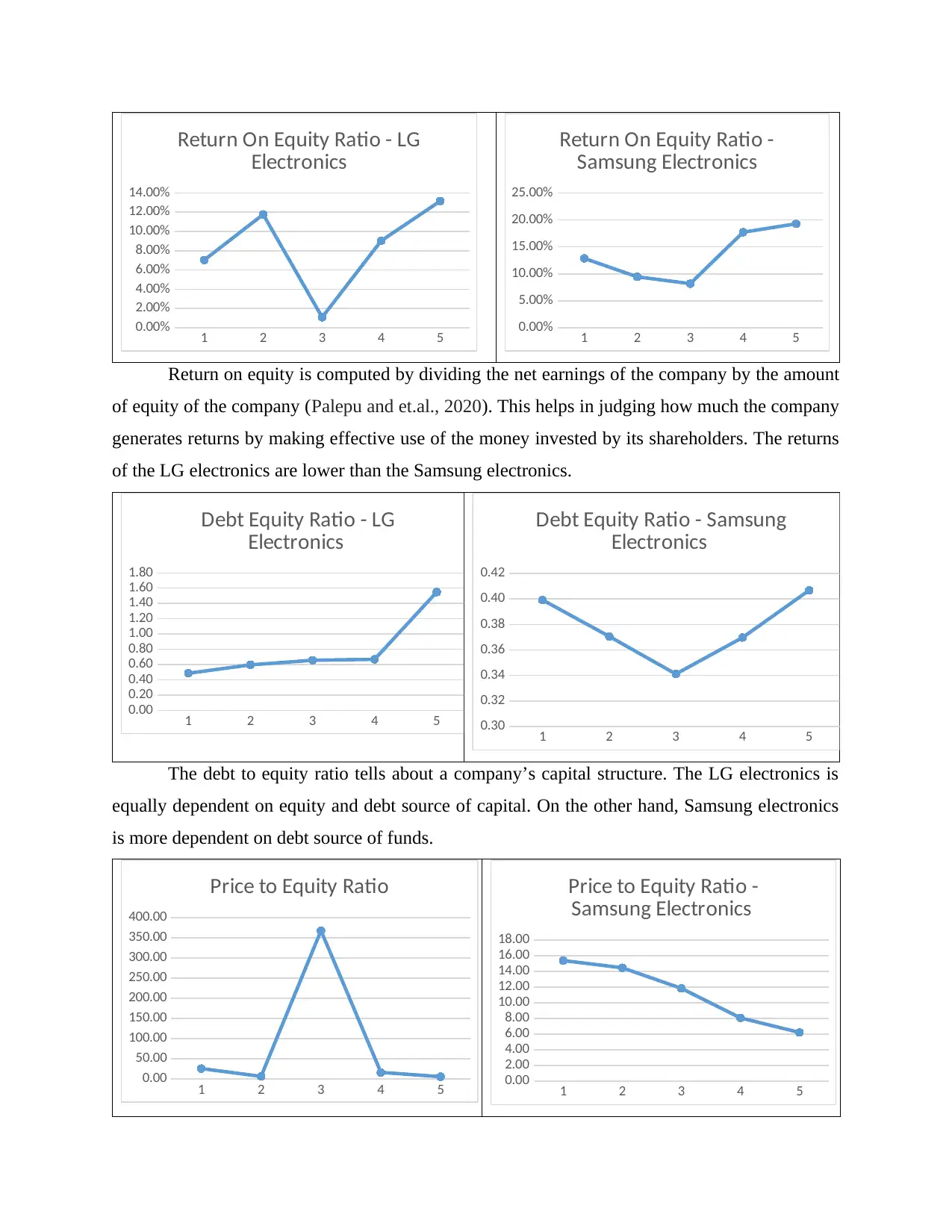
0.00%
2.00%
4.00%
6.00%
8.00%
10.00%
12.00%
14.00%
Return On Equity Ratio - LG
Electronics
1 2 3 4 5
0.00%
5.00%
10.00%
15.00%
20.00%
25.00%
Return On Equity Ratio -
Samsung Electronics
Return on equity is computed by dividing the net earnings of the company by the amount
of equity of the company (Palepu and et.al., 2020). This helps in judging how much the company
generates returns by making effective use of the money invested by its shareholders. The returns
of the LG electronics are lower than the Samsung electronics.
1 2 3 4 5
0.00
0.20
0.40
0.60
0.80
1.00
1.20
1.40
1.60
1.80
Debt Equity Ratio - LG
Electronics
1 2 3 4 5
0.30
0.32
0.34
0.36
0.38
0.40
0.42
Debt Equity Ratio - Samsung
Electronics
The debt to equity ratio tells about a company’s capital structure. The LG electronics is
equally dependent on equity and debt source of capital. On the other hand, Samsung electronics
is more dependent on debt source of funds.
1 2 3 4 5
0.00
50.00
100.00
150.00
200.00
250.00
300.00
350.00
400.00
Price to Equity Ratio
1 2 3 4 5
0.00
2.00
4.00
6.00
8.00
10.00
12.00
14.00
16.00
18.00
Price to Equity Ratio -
Samsung Electronics
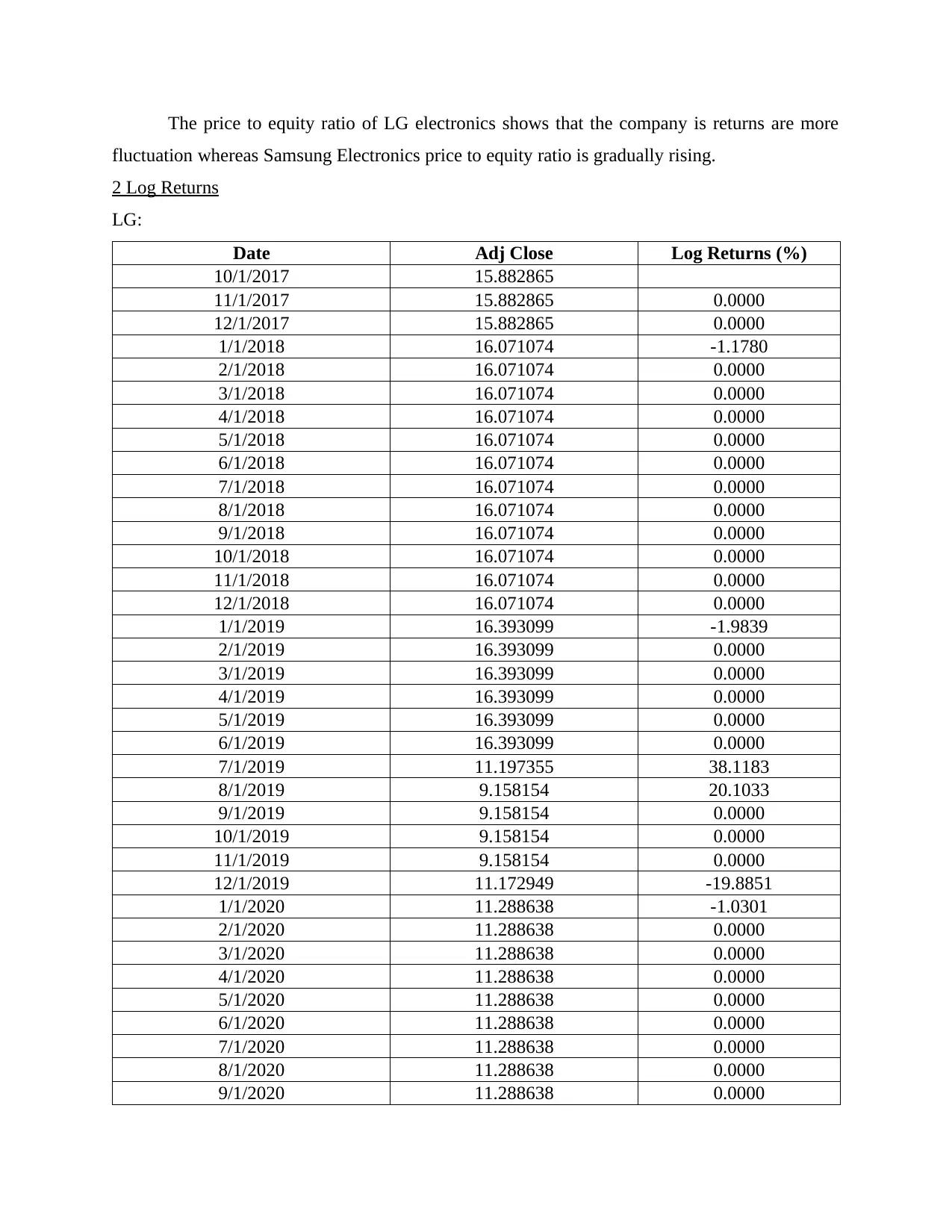
fluctuation whereas Samsung Electronics price to equity ratio is gradually rising.
2 Log Returns
LG:
Date Adj Close Log Returns (%)
10/1/2017 15.882865
11/1/2017 15.882865 0.0000
12/1/2017 15.882865 0.0000
1/1/2018 16.071074 -1.1780
2/1/2018 16.071074 0.0000
3/1/2018 16.071074 0.0000
4/1/2018 16.071074 0.0000
5/1/2018 16.071074 0.0000
6/1/2018 16.071074 0.0000
7/1/2018 16.071074 0.0000
8/1/2018 16.071074 0.0000
9/1/2018 16.071074 0.0000
10/1/2018 16.071074 0.0000
11/1/2018 16.071074 0.0000
12/1/2018 16.071074 0.0000
1/1/2019 16.393099 -1.9839
2/1/2019 16.393099 0.0000
3/1/2019 16.393099 0.0000
4/1/2019 16.393099 0.0000
5/1/2019 16.393099 0.0000
6/1/2019 16.393099 0.0000
7/1/2019 11.197355 38.1183
8/1/2019 9.158154 20.1033
9/1/2019 9.158154 0.0000
10/1/2019 9.158154 0.0000
11/1/2019 9.158154 0.0000
12/1/2019 11.172949 -19.8851
1/1/2020 11.288638 -1.0301
2/1/2020 11.288638 0.0000
3/1/2020 11.288638 0.0000
4/1/2020 11.288638 0.0000
5/1/2020 11.288638 0.0000
6/1/2020 11.288638 0.0000
7/1/2020 11.288638 0.0000
8/1/2020 11.288638 0.0000
9/1/2020 11.288638 0.0000
⊘ This is a preview!⊘
Do you want full access?
Subscribe today to unlock all pages.

Trusted by 1+ million students worldwide
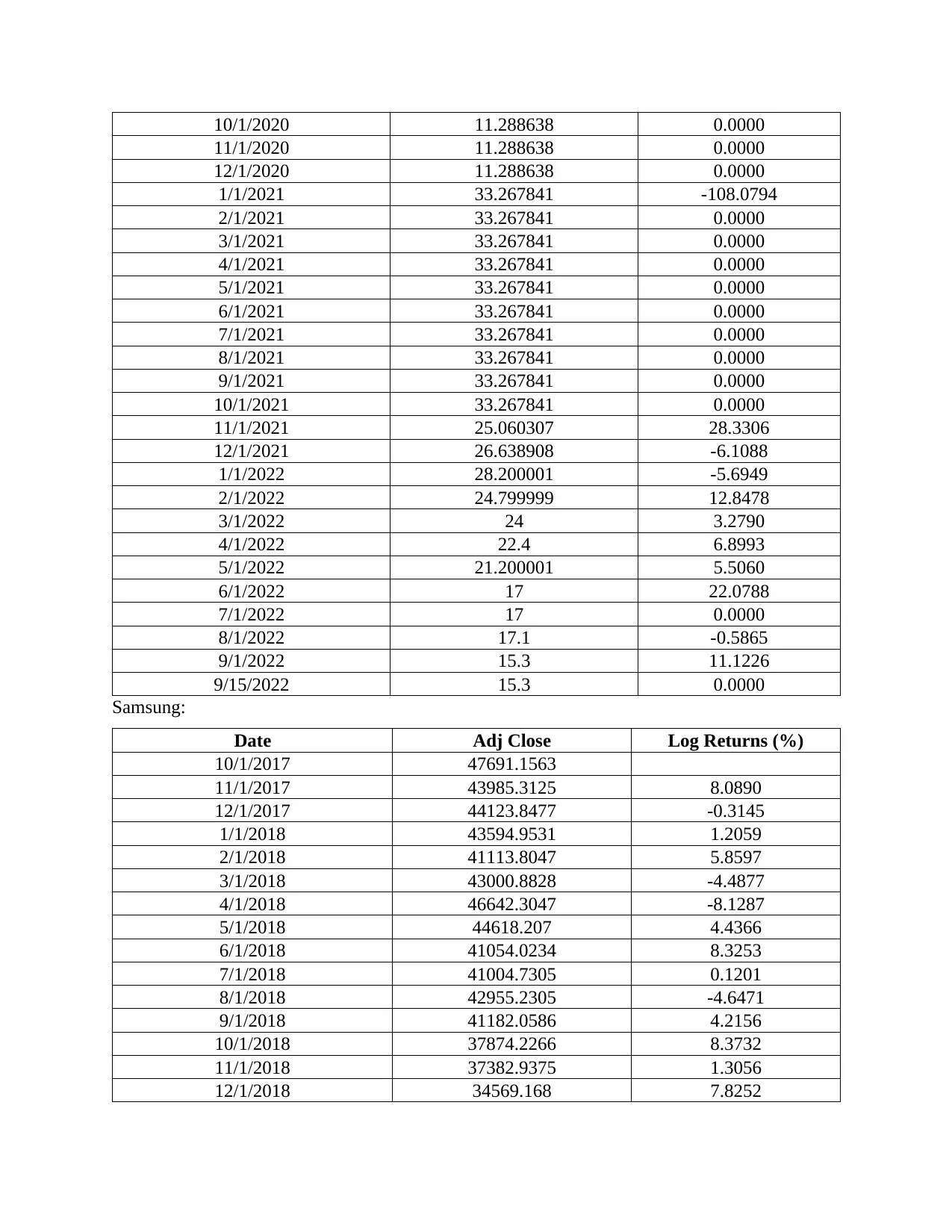
11/1/2020 11.288638 0.0000
12/1/2020 11.288638 0.0000
1/1/2021 33.267841 -108.0794
2/1/2021 33.267841 0.0000
3/1/2021 33.267841 0.0000
4/1/2021 33.267841 0.0000
5/1/2021 33.267841 0.0000
6/1/2021 33.267841 0.0000
7/1/2021 33.267841 0.0000
8/1/2021 33.267841 0.0000
9/1/2021 33.267841 0.0000
10/1/2021 33.267841 0.0000
11/1/2021 25.060307 28.3306
12/1/2021 26.638908 -6.1088
1/1/2022 28.200001 -5.6949
2/1/2022 24.799999 12.8478
3/1/2022 24 3.2790
4/1/2022 22.4 6.8993
5/1/2022 21.200001 5.5060
6/1/2022 17 22.0788
7/1/2022 17 0.0000
8/1/2022 17.1 -0.5865
9/1/2022 15.3 11.1226
9/15/2022 15.3 0.0000
Samsung:
Date Adj Close Log Returns (%)
10/1/2017 47691.1563
11/1/2017 43985.3125 8.0890
12/1/2017 44123.8477 -0.3145
1/1/2018 43594.9531 1.2059
2/1/2018 41113.8047 5.8597
3/1/2018 43000.8828 -4.4877
4/1/2018 46642.3047 -8.1287
5/1/2018 44618.207 4.4366
6/1/2018 41054.0234 8.3253
7/1/2018 41004.7305 0.1201
8/1/2018 42955.2305 -4.6471
9/1/2018 41182.0586 4.2156
10/1/2018 37874.2266 8.3732
11/1/2018 37382.9375 1.3056
12/1/2018 34569.168 7.8252
Paraphrase This Document
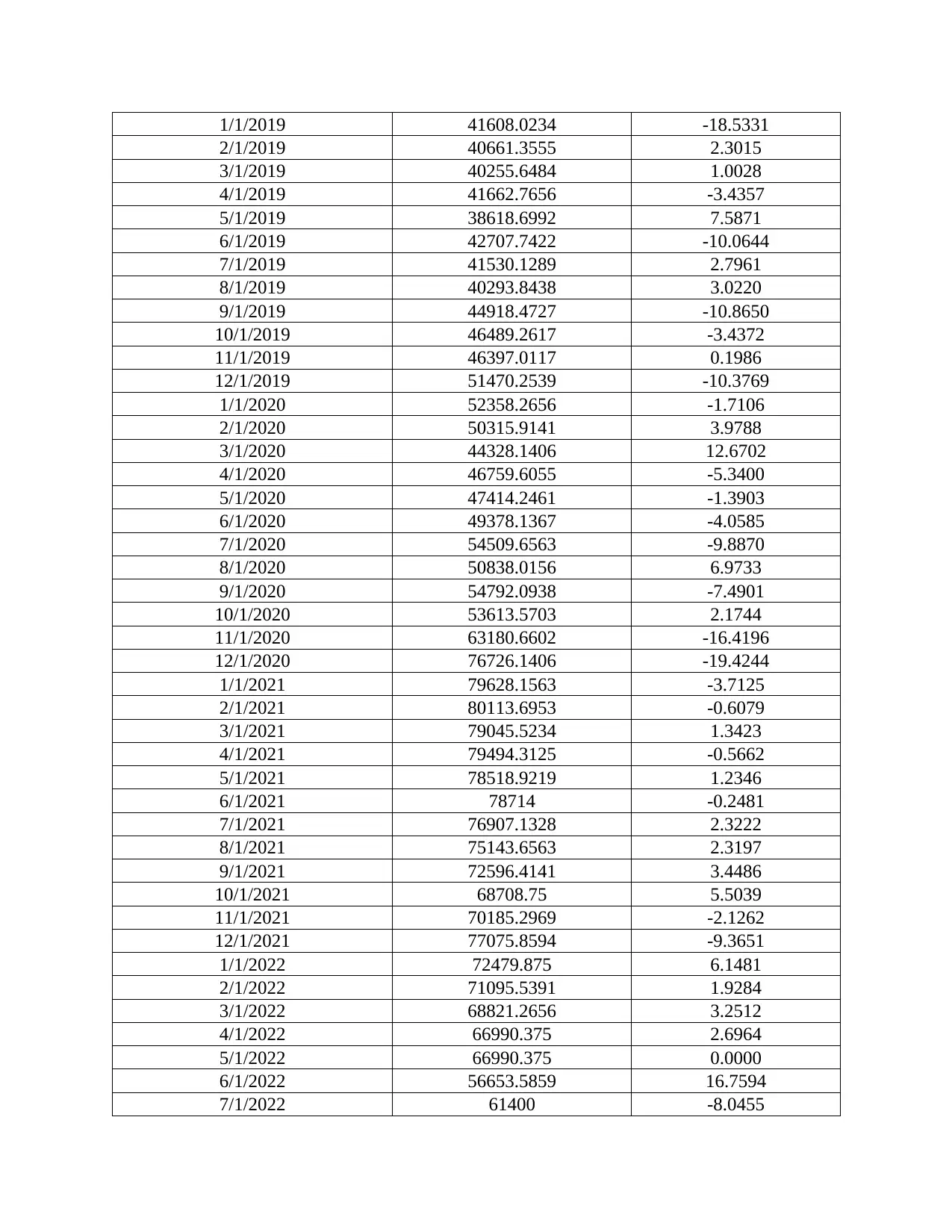
2/1/2019 40661.3555 2.3015
3/1/2019 40255.6484 1.0028
4/1/2019 41662.7656 -3.4357
5/1/2019 38618.6992 7.5871
6/1/2019 42707.7422 -10.0644
7/1/2019 41530.1289 2.7961
8/1/2019 40293.8438 3.0220
9/1/2019 44918.4727 -10.8650
10/1/2019 46489.2617 -3.4372
11/1/2019 46397.0117 0.1986
12/1/2019 51470.2539 -10.3769
1/1/2020 52358.2656 -1.7106
2/1/2020 50315.9141 3.9788
3/1/2020 44328.1406 12.6702
4/1/2020 46759.6055 -5.3400
5/1/2020 47414.2461 -1.3903
6/1/2020 49378.1367 -4.0585
7/1/2020 54509.6563 -9.8870
8/1/2020 50838.0156 6.9733
9/1/2020 54792.0938 -7.4901
10/1/2020 53613.5703 2.1744
11/1/2020 63180.6602 -16.4196
12/1/2020 76726.1406 -19.4244
1/1/2021 79628.1563 -3.7125
2/1/2021 80113.6953 -0.6079
3/1/2021 79045.5234 1.3423
4/1/2021 79494.3125 -0.5662
5/1/2021 78518.9219 1.2346
6/1/2021 78714 -0.2481
7/1/2021 76907.1328 2.3222
8/1/2021 75143.6563 2.3197
9/1/2021 72596.4141 3.4486
10/1/2021 68708.75 5.5039
11/1/2021 70185.2969 -2.1262
12/1/2021 77075.8594 -9.3651
1/1/2022 72479.875 6.1481
2/1/2022 71095.5391 1.9284
3/1/2022 68821.2656 3.2512
4/1/2022 66990.375 2.6964
5/1/2022 66990.375 0.0000
6/1/2022 56653.5859 16.7594
7/1/2022 61400 -8.0455
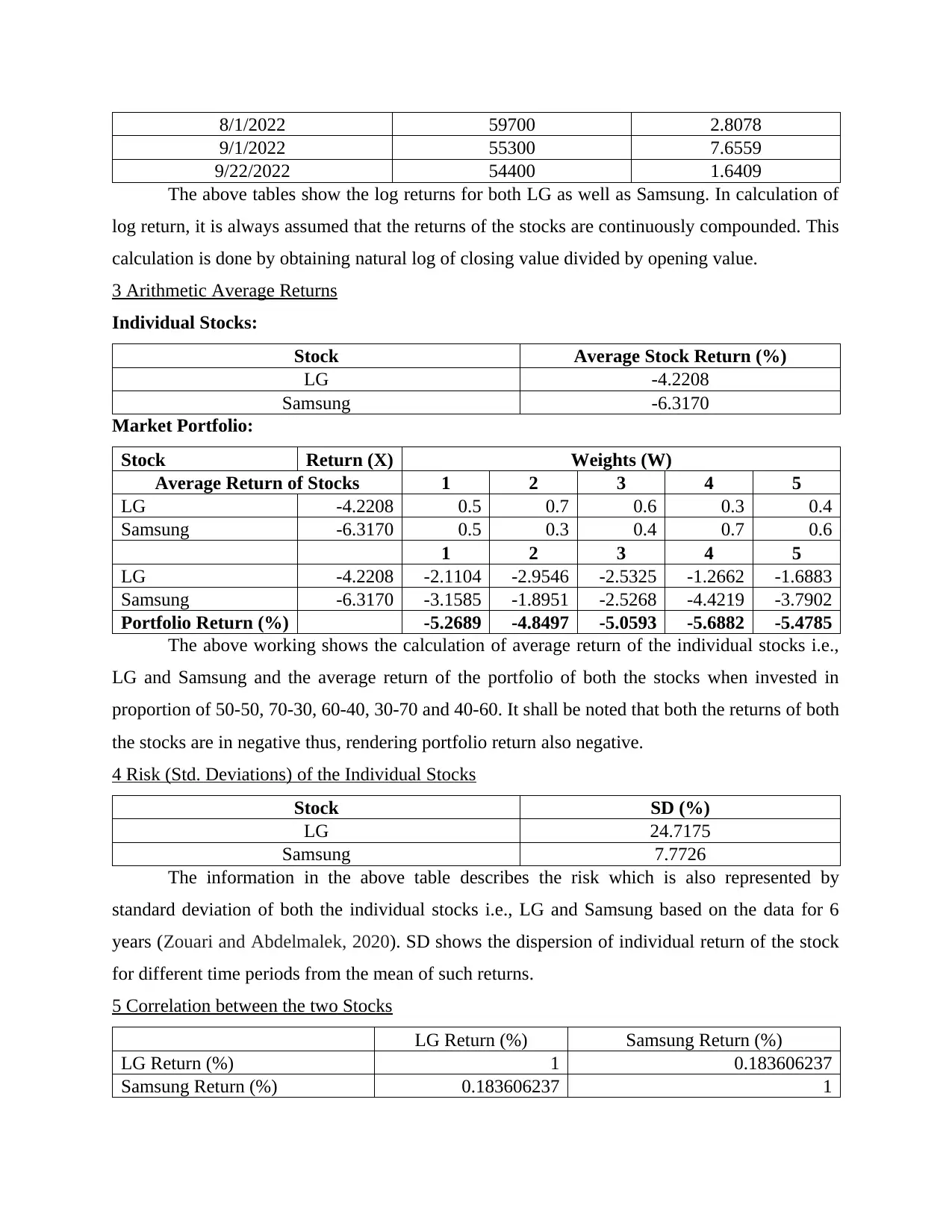
9/1/2022 55300 7.6559
9/22/2022 54400 1.6409
The above tables show the log returns for both LG as well as Samsung. In calculation of
log return, it is always assumed that the returns of the stocks are continuously compounded. This
calculation is done by obtaining natural log of closing value divided by opening value.
3 Arithmetic Average Returns
Individual Stocks:
Stock Average Stock Return (%)
LG -4.2208
Samsung -6.3170
Market Portfolio:
Stock Return (X) Weights (W)
Average Return of Stocks 1 2 3 4 5
LG -4.2208 0.5 0.7 0.6 0.3 0.4
Samsung -6.3170 0.5 0.3 0.4 0.7 0.6
1 2 3 4 5
LG -4.2208 -2.1104 -2.9546 -2.5325 -1.2662 -1.6883
Samsung -6.3170 -3.1585 -1.8951 -2.5268 -4.4219 -3.7902
Portfolio Return (%) -5.2689 -4.8497 -5.0593 -5.6882 -5.4785
The above working shows the calculation of average return of the individual stocks i.e.,
LG and Samsung and the average return of the portfolio of both the stocks when invested in
proportion of 50-50, 70-30, 60-40, 30-70 and 40-60. It shall be noted that both the returns of both
the stocks are in negative thus, rendering portfolio return also negative.
4 Risk (Std. Deviations) of the Individual Stocks
Stock SD (%)
LG 24.7175
Samsung 7.7726
The information in the above table describes the risk which is also represented by
standard deviation of both the individual stocks i.e., LG and Samsung based on the data for 6
years (Zouari and Abdelmalek, 2020). SD shows the dispersion of individual return of the stock
for different time periods from the mean of such returns.
5 Correlation between the two Stocks
LG Return (%) Samsung Return (%)
LG Return (%) 1 0.183606237
Samsung Return (%) 0.183606237 1
⊘ This is a preview!⊘
Do you want full access?
Subscribe today to unlock all pages.

Trusted by 1+ million students worldwide
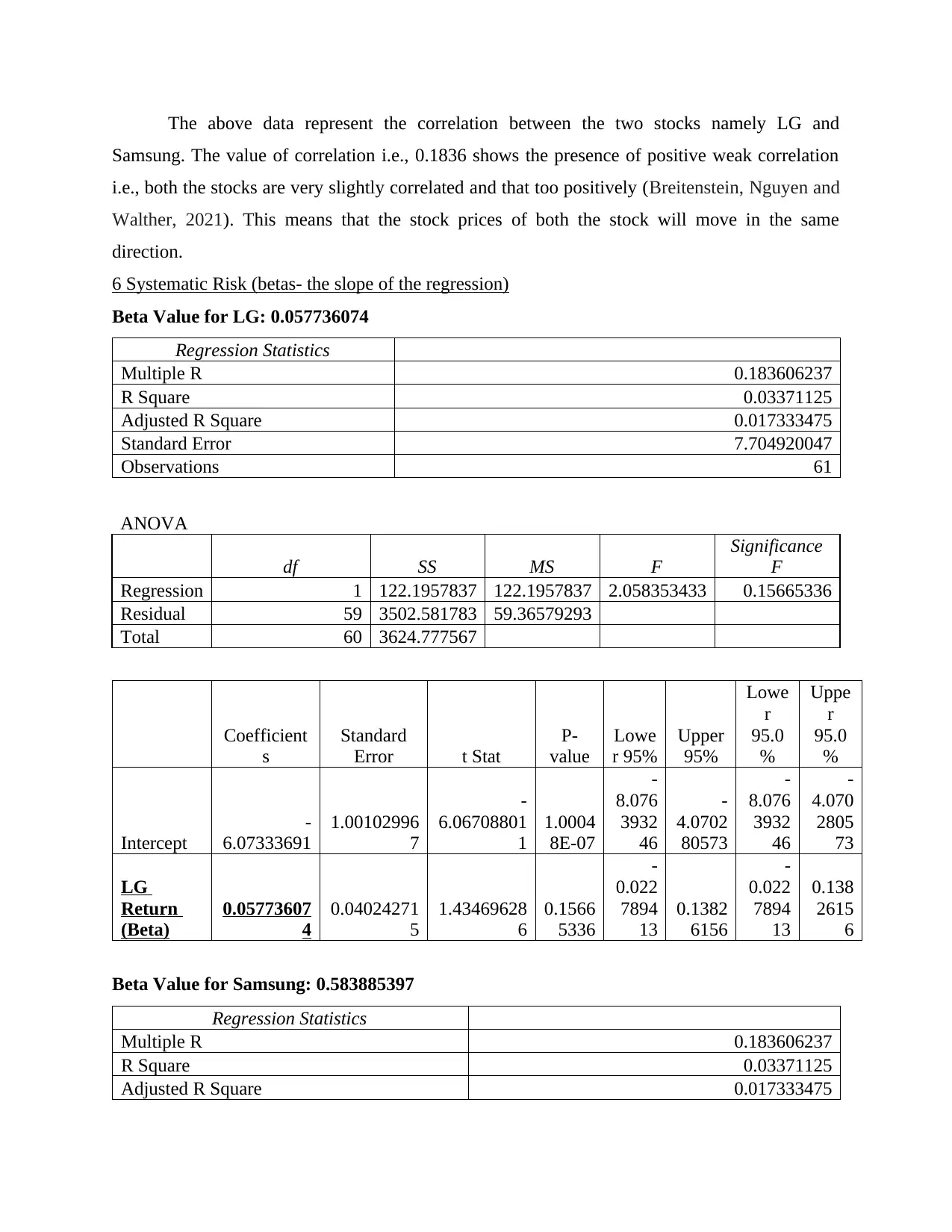
Samsung. The value of correlation i.e., 0.1836 shows the presence of positive weak correlation
i.e., both the stocks are very slightly correlated and that too positively (Breitenstein, Nguyen and
Walther, 2021). This means that the stock prices of both the stock will move in the same
direction.
6 Systematic Risk (betas- the slope of the regression)
Beta Value for LG: 0.057736074
Regression Statistics
Multiple R 0.183606237
R Square 0.03371125
Adjusted R Square 0.017333475
Standard Error 7.704920047
Observations 61
ANOVA
df SS MS F
Significance
F
Regression 1 122.1957837 122.1957837 2.058353433 0.15665336
Residual 59 3502.581783 59.36579293
Total 60 3624.777567
Coefficient
s
Standard
Error t Stat
P-
value
Lowe
r 95%
Upper
95%
Lowe
r
95.0
%
Uppe
r
95.0
%
Intercept
-
6.07333691
1.00102996
7
-
6.06708801
1
1.0004
8E-07
-
8.076
3932
46
-
4.0702
80573
-
8.076
3932
46
-
4.070
2805
73
LG
Return
(Beta)
0.05773607
4
0.04024271
5
1.43469628
6
0.1566
5336
-
0.022
7894
13
0.1382
6156
-
0.022
7894
13
0.138
2615
6
Beta Value for Samsung: 0.583885397
Regression Statistics
Multiple R 0.183606237
R Square 0.03371125
Adjusted R Square 0.017333475
Paraphrase This Document
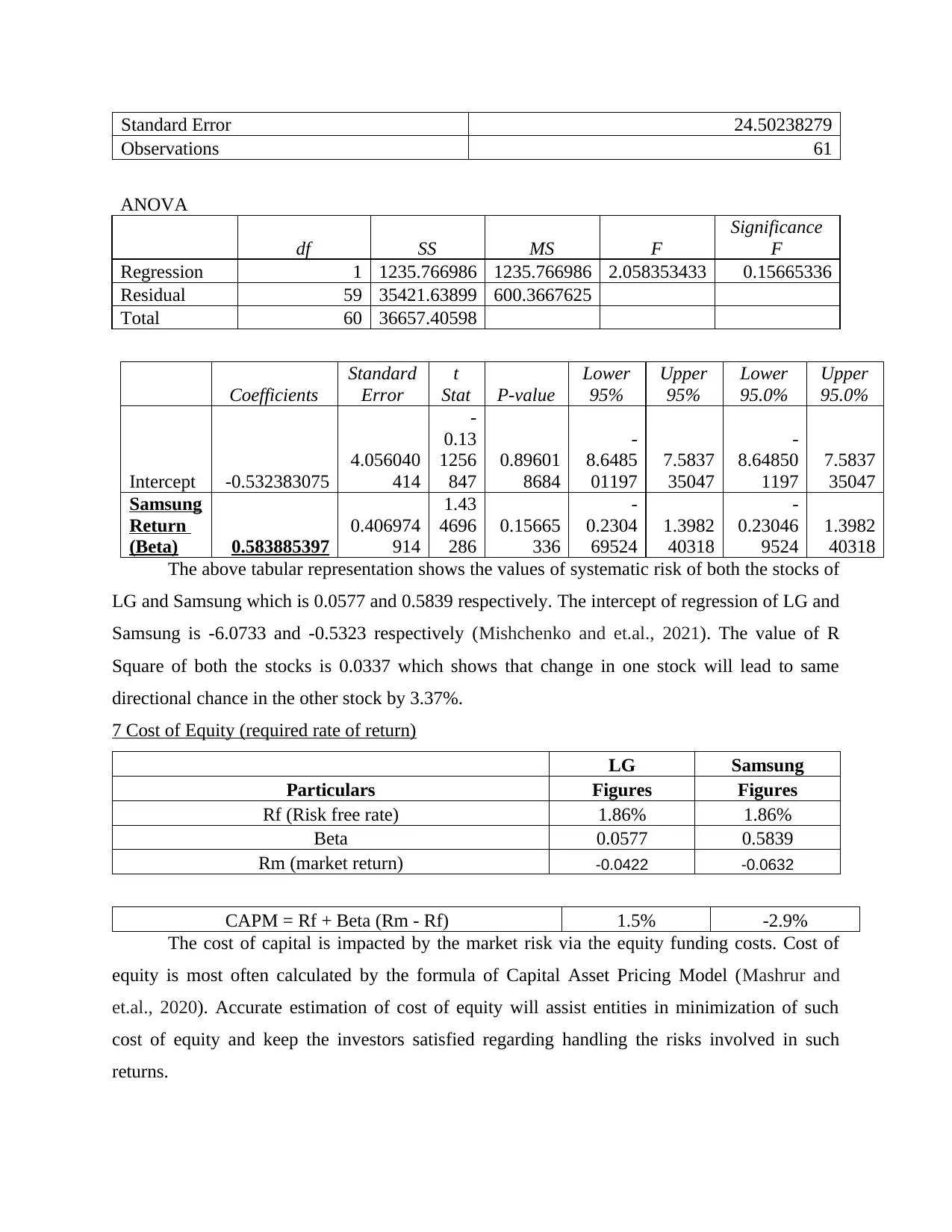
Observations 61
ANOVA
df SS MS F
Significance
F
Regression 1 1235.766986 1235.766986 2.058353433 0.15665336
Residual 59 35421.63899 600.3667625
Total 60 36657.40598
Coefficients
Standard
Error
t
Stat P-value
Lower
95%
Upper
95%
Lower
95.0%
Upper
95.0%
Intercept -0.532383075
4.056040
414
-
0.13
1256
847
0.89601
8684
-
8.6485
01197
7.5837
35047
-
8.64850
1197
7.5837
35047
Samsung
Return
(Beta) 0.583885397
0.406974
914
1.43
4696
286
0.15665
336
-
0.2304
69524
1.3982
40318
-
0.23046
9524
1.3982
40318
The above tabular representation shows the values of systematic risk of both the stocks of
LG and Samsung which is 0.0577 and 0.5839 respectively. The intercept of regression of LG and
Samsung is -6.0733 and -0.5323 respectively (Mishchenko and et.al., 2021). The value of R
Square of both the stocks is 0.0337 which shows that change in one stock will lead to same
directional chance in the other stock by 3.37%.
7 Cost of Equity (required rate of return)
LG Samsung
Particulars Figures Figures
Rf (Risk free rate) 1.86% 1.86%
Beta 0.0577 0.5839
Rm (market return) -0.0422 -0.0632
CAPM = Rf + Beta (Rm - Rf) 1.5% -2.9%
The cost of capital is impacted by the market risk via the equity funding costs. Cost of
equity is most often calculated by the formula of Capital Asset Pricing Model (Mashrur and
et.al., 2020). Accurate estimation of cost of equity will assist entities in minimization of such
cost of equity and keep the investors satisfied regarding handling the risks involved in such
returns.
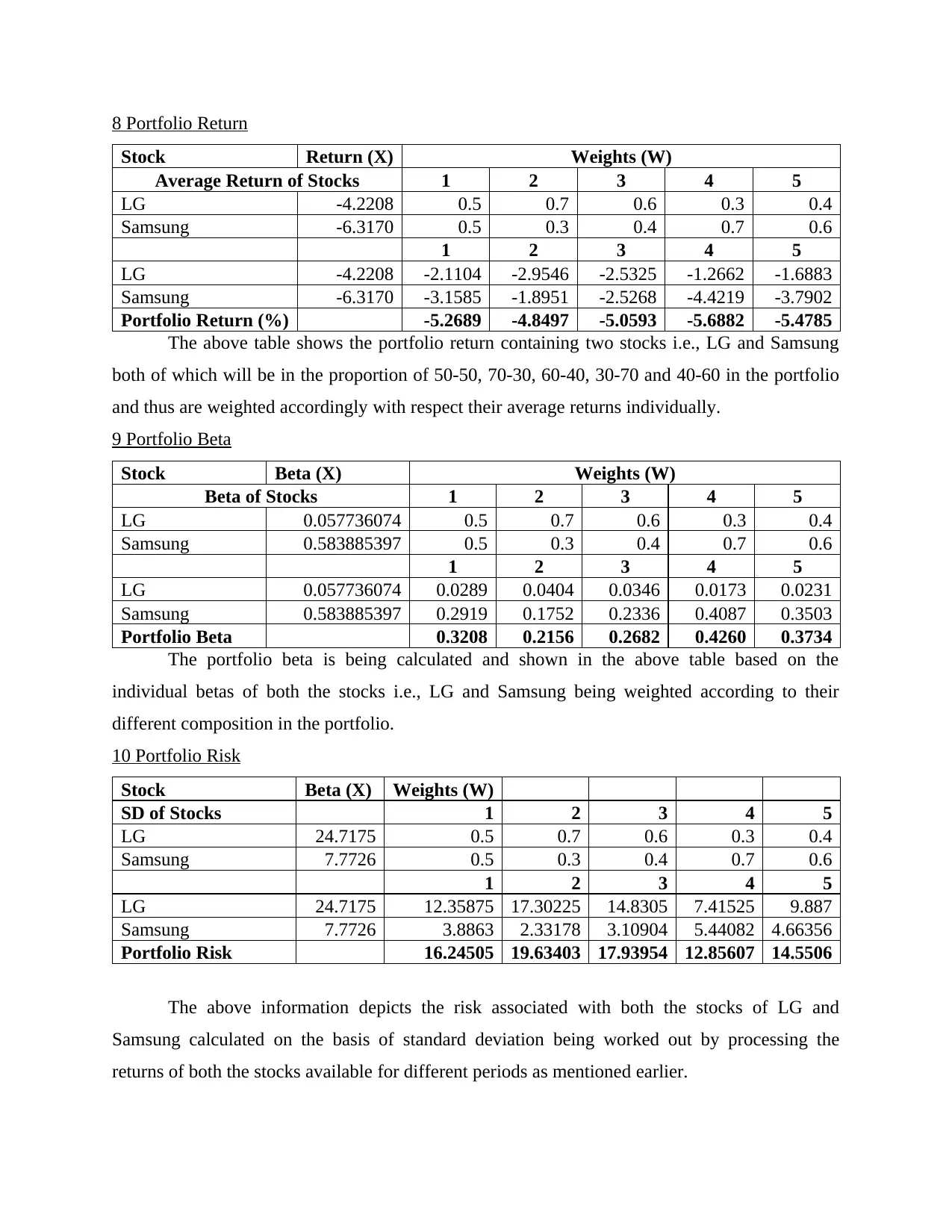
Stock Return (X) Weights (W)
Average Return of Stocks 1 2 3 4 5
LG -4.2208 0.5 0.7 0.6 0.3 0.4
Samsung -6.3170 0.5 0.3 0.4 0.7 0.6
1 2 3 4 5
LG -4.2208 -2.1104 -2.9546 -2.5325 -1.2662 -1.6883
Samsung -6.3170 -3.1585 -1.8951 -2.5268 -4.4219 -3.7902
Portfolio Return (%) -5.2689 -4.8497 -5.0593 -5.6882 -5.4785
The above table shows the portfolio return containing two stocks i.e., LG and Samsung
both of which will be in the proportion of 50-50, 70-30, 60-40, 30-70 and 40-60 in the portfolio
and thus are weighted accordingly with respect their average returns individually.
9 Portfolio Beta
Stock Beta (X) Weights (W)
Beta of Stocks 1 2 3 4 5
LG 0.057736074 0.5 0.7 0.6 0.3 0.4
Samsung 0.583885397 0.5 0.3 0.4 0.7 0.6
1 2 3 4 5
LG 0.057736074 0.0289 0.0404 0.0346 0.0173 0.0231
Samsung 0.583885397 0.2919 0.1752 0.2336 0.4087 0.3503
Portfolio Beta 0.3208 0.2156 0.2682 0.4260 0.3734
The portfolio beta is being calculated and shown in the above table based on the
individual betas of both the stocks i.e., LG and Samsung being weighted according to their
different composition in the portfolio.
10 Portfolio Risk
Stock Beta (X) Weights (W)
SD of Stocks 1 2 3 4 5
LG 24.7175 0.5 0.7 0.6 0.3 0.4
Samsung 7.7726 0.5 0.3 0.4 0.7 0.6
1 2 3 4 5
LG 24.7175 12.35875 17.30225 14.8305 7.41525 9.887
Samsung 7.7726 3.8863 2.33178 3.10904 5.44082 4.66356
Portfolio Risk 16.24505 19.63403 17.93954 12.85607 14.5506
The above information depicts the risk associated with both the stocks of LG and
Samsung calculated on the basis of standard deviation being worked out by processing the
returns of both the stocks available for different periods as mentioned earlier.
⊘ This is a preview!⊘
Do you want full access?
Subscribe today to unlock all pages.

Trusted by 1+ million students worldwide
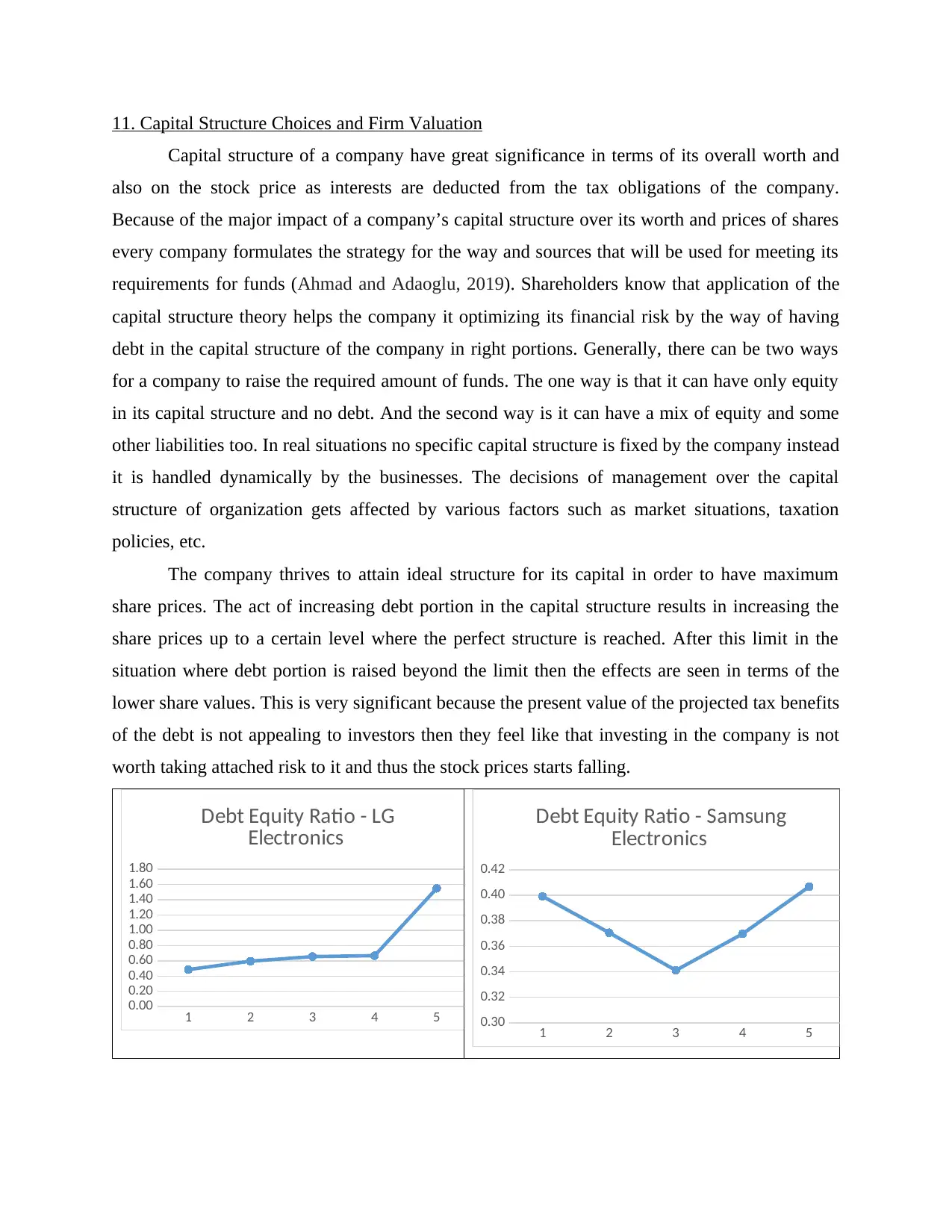
Capital structure of a company have great significance in terms of its overall worth and
also on the stock price as interests are deducted from the tax obligations of the company.
Because of the major impact of a company’s capital structure over its worth and prices of shares
every company formulates the strategy for the way and sources that will be used for meeting its
requirements for funds (Ahmad and Adaoglu, 2019). Shareholders know that application of the
capital structure theory helps the company it optimizing its financial risk by the way of having
debt in the capital structure of the company in right portions. Generally, there can be two ways
for a company to raise the required amount of funds. The one way is that it can have only equity
in its capital structure and no debt. And the second way is it can have a mix of equity and some
other liabilities too. In real situations no specific capital structure is fixed by the company instead
it is handled dynamically by the businesses. The decisions of management over the capital
structure of organization gets affected by various factors such as market situations, taxation
policies, etc.
The company thrives to attain ideal structure for its capital in order to have maximum
share prices. The act of increasing debt portion in the capital structure results in increasing the
share prices up to a certain level where the perfect structure is reached. After this limit in the
situation where debt portion is raised beyond the limit then the effects are seen in terms of the
lower share values. This is very significant because the present value of the projected tax benefits
of the debt is not appealing to investors then they feel like that investing in the company is not
worth taking attached risk to it and thus the stock prices starts falling.
1 2 3 4 5
0.00
0.20
0.40
0.60
0.80
1.00
1.20
1.40
1.60
1.80
Debt Equity Ratio - LG
Electronics
1 2 3 4 5
0.30
0.32
0.34
0.36
0.38
0.40
0.42
Debt Equity Ratio - Samsung
Electronics
Paraphrase This Document
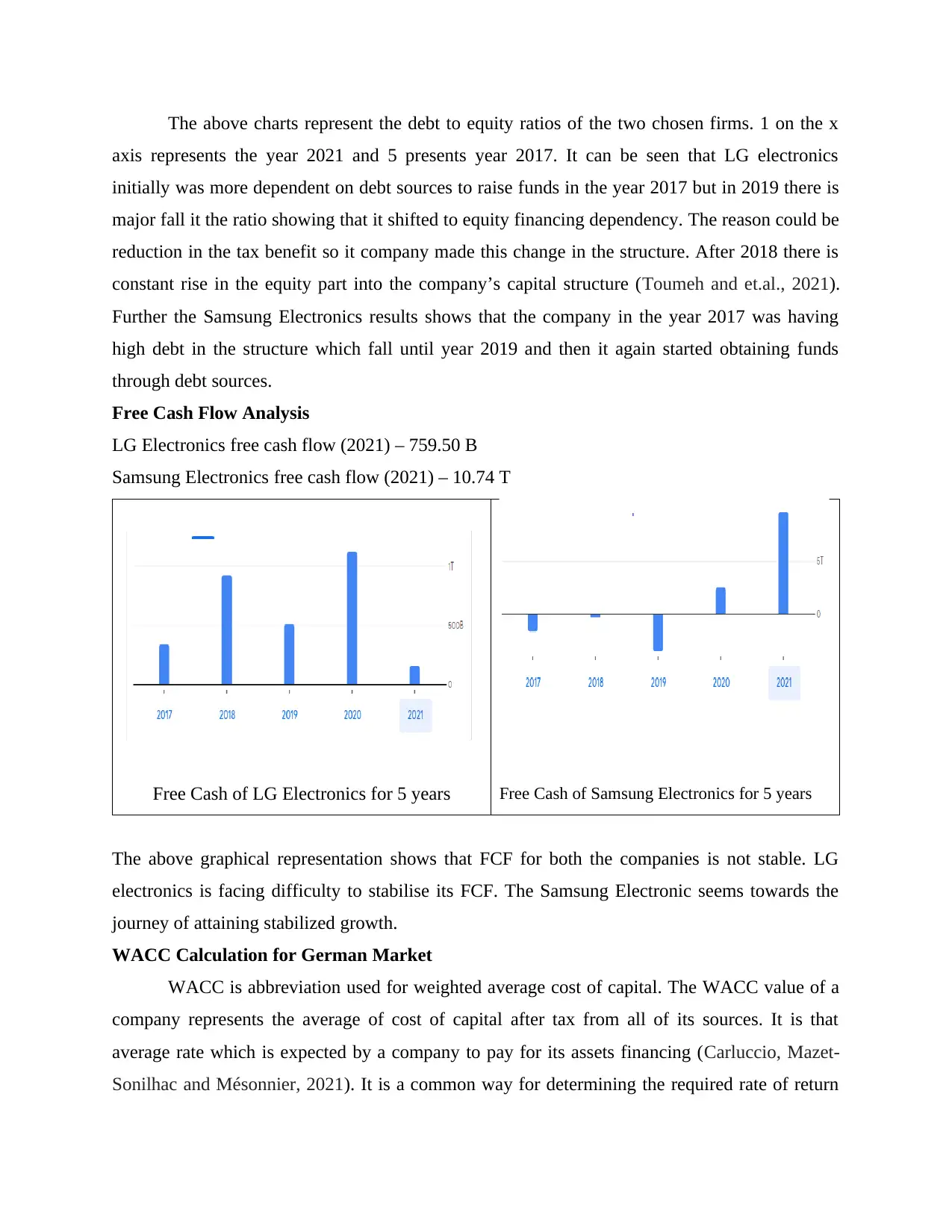
axis represents the year 2021 and 5 presents year 2017. It can be seen that LG electronics
initially was more dependent on debt sources to raise funds in the year 2017 but in 2019 there is
major fall it the ratio showing that it shifted to equity financing dependency. The reason could be
reduction in the tax benefit so it company made this change in the structure. After 2018 there is
constant rise in the equity part into the company’s capital structure (Toumeh and et.al., 2021).
Further the Samsung Electronics results shows that the company in the year 2017 was having
high debt in the structure which fall until year 2019 and then it again started obtaining funds
through debt sources.
Free Cash Flow Analysis
LG Electronics free cash flow (2021) – 759.50 B
Samsung Electronics free cash flow (2021) – 10.74 T
Free Cash of LG Electronics for 5 years Free Cash of Samsung Electronics for 5 years
The above graphical representation shows that FCF for both the companies is not stable. LG
electronics is facing difficulty to stabilise its FCF. The Samsung Electronic seems towards the
journey of attaining stabilized growth.
WACC Calculation for German Market
WACC is abbreviation used for weighted average cost of capital. The WACC value of a
company represents the average of cost of capital after tax from all of its sources. It is that
average rate which is expected by a company to pay for its assets financing (Carluccio, Mazet-
Sonilhac and Mésonnier, 2021). It is a common way for determining the required rate of return
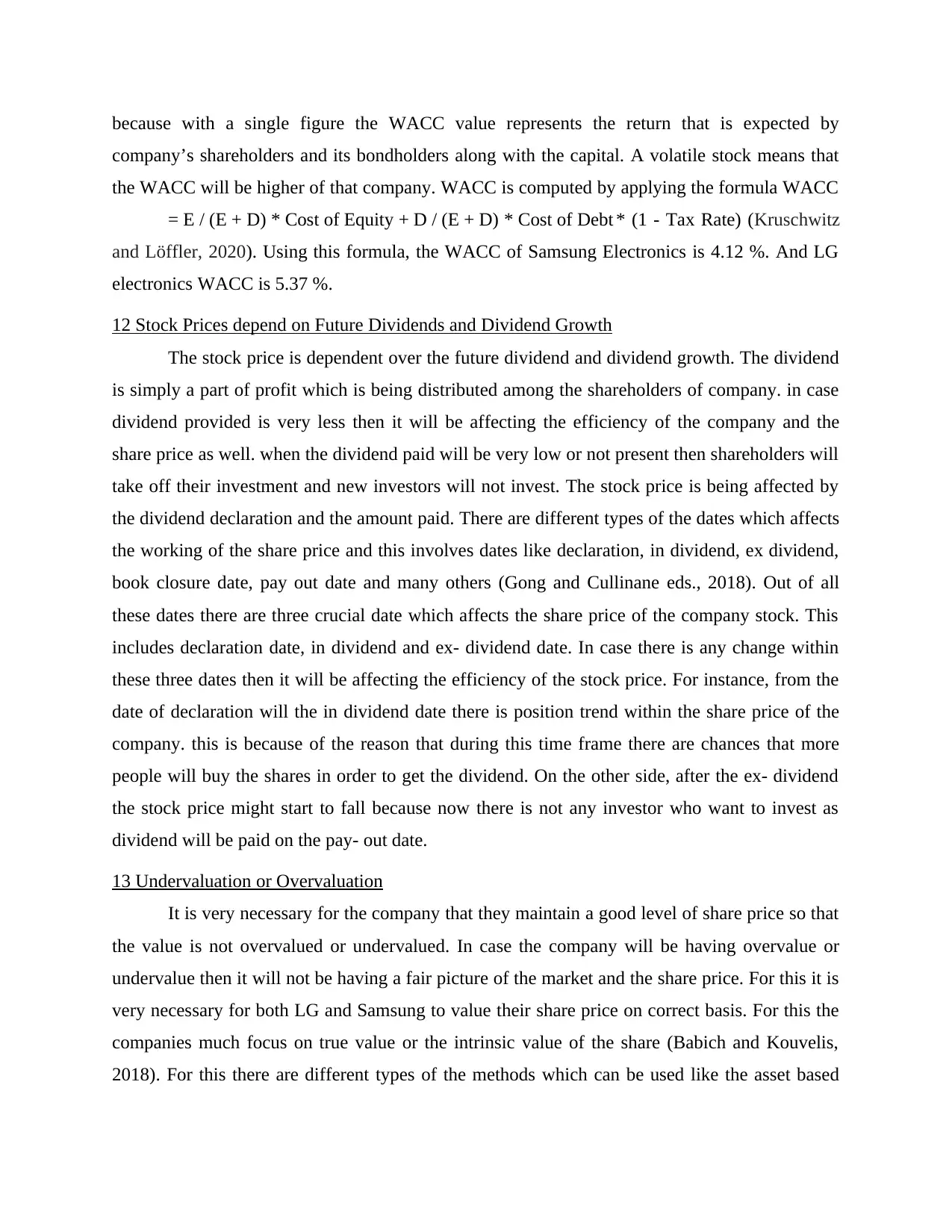
company’s shareholders and its bondholders along with the capital. A volatile stock means that
the WACC will be higher of that company. WACC is computed by applying the formula WACC
= E / (E + D) * Cost of Equity + D / (E + D) * Cost of Debt * (1 - Tax Rate) (Kruschwitz
and Löffler, 2020). Using this formula, the WACC of Samsung Electronics is 4.12 %. And LG
electronics WACC is 5.37 %.
12 Stock Prices depend on Future Dividends and Dividend Growth
The stock price is dependent over the future dividend and dividend growth. The dividend
is simply a part of profit which is being distributed among the shareholders of company. in case
dividend provided is very less then it will be affecting the efficiency of the company and the
share price as well. when the dividend paid will be very low or not present then shareholders will
take off their investment and new investors will not invest. The stock price is being affected by
the dividend declaration and the amount paid. There are different types of the dates which affects
the working of the share price and this involves dates like declaration, in dividend, ex dividend,
book closure date, pay out date and many others (Gong and Cullinane eds., 2018). Out of all
these dates there are three crucial date which affects the share price of the company stock. This
includes declaration date, in dividend and ex- dividend date. In case there is any change within
these three dates then it will be affecting the efficiency of the stock price. For instance, from the
date of declaration will the in dividend date there is position trend within the share price of the
company. this is because of the reason that during this time frame there are chances that more
people will buy the shares in order to get the dividend. On the other side, after the ex- dividend
the stock price might start to fall because now there is not any investor who want to invest as
dividend will be paid on the pay- out date.
13 Undervaluation or Overvaluation
It is very necessary for the company that they maintain a good level of share price so that
the value is not overvalued or undervalued. In case the company will be having overvalue or
undervalue then it will not be having a fair picture of the market and the share price. For this it is
very necessary for both LG and Samsung to value their share price on correct basis. For this the
companies much focus on true value or the intrinsic value of the share (Babich and Kouvelis,
2018). For this there are different types of the methods which can be used like the asset based
⊘ This is a preview!⊘
Do you want full access?
Subscribe today to unlock all pages.

Trusted by 1+ million students worldwide
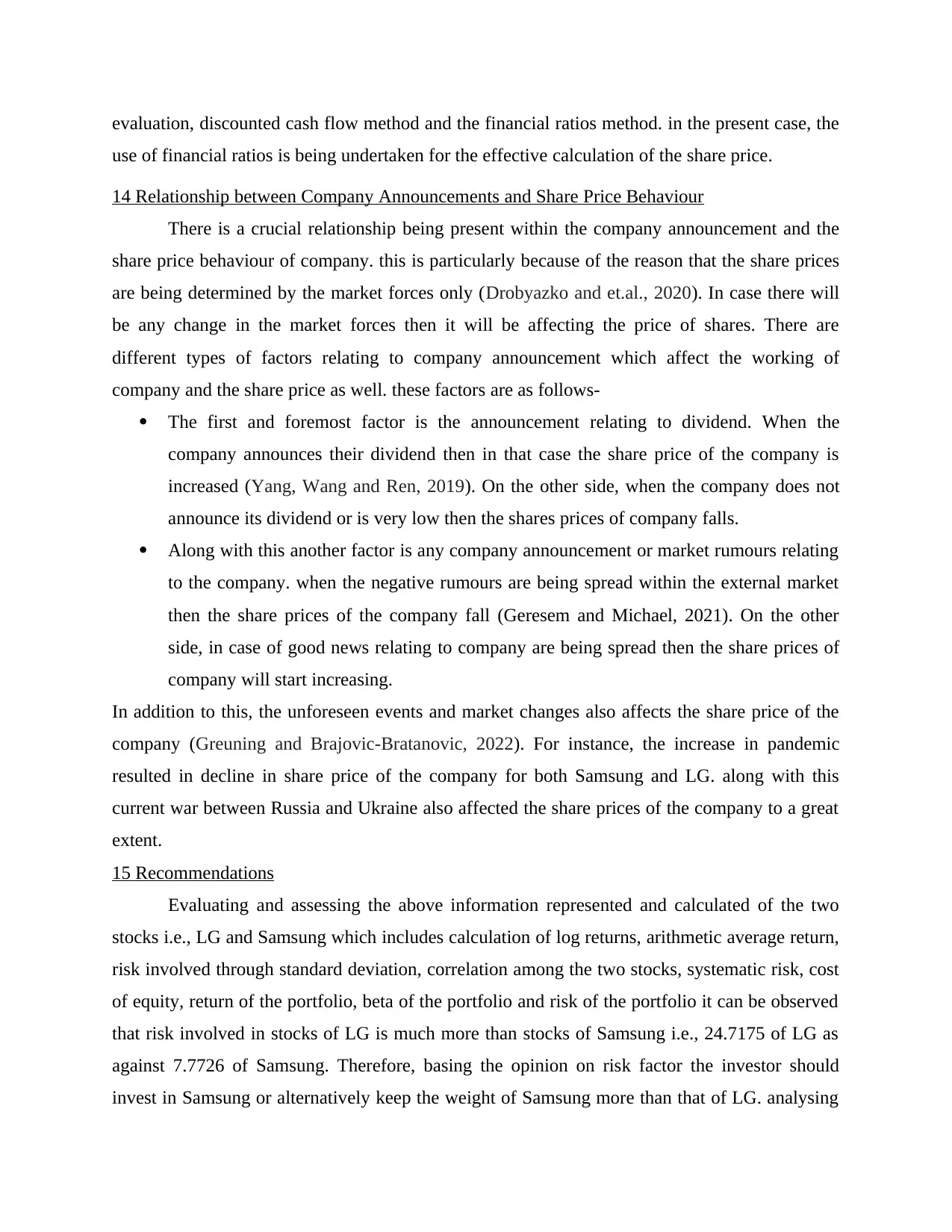
use of financial ratios is being undertaken for the effective calculation of the share price.
14 Relationship between Company Announcements and Share Price Behaviour
There is a crucial relationship being present within the company announcement and the
share price behaviour of company. this is particularly because of the reason that the share prices
are being determined by the market forces only (Drobyazko and et.al., 2020). In case there will
be any change in the market forces then it will be affecting the price of shares. There are
different types of factors relating to company announcement which affect the working of
company and the share price as well. these factors are as follows-
The first and foremost factor is the announcement relating to dividend. When the
company announces their dividend then in that case the share price of the company is
increased (Yang, Wang and Ren, 2019). On the other side, when the company does not
announce its dividend or is very low then the shares prices of company falls.
Along with this another factor is any company announcement or market rumours relating
to the company. when the negative rumours are being spread within the external market
then the share prices of the company fall (Geresem and Michael, 2021). On the other
side, in case of good news relating to company are being spread then the share prices of
company will start increasing.
In addition to this, the unforeseen events and market changes also affects the share price of the
company (Greuning and Brajovic-Bratanovic, 2022). For instance, the increase in pandemic
resulted in decline in share price of the company for both Samsung and LG. along with this
current war between Russia and Ukraine also affected the share prices of the company to a great
extent.
15 Recommendations
Evaluating and assessing the above information represented and calculated of the two
stocks i.e., LG and Samsung which includes calculation of log returns, arithmetic average return,
risk involved through standard deviation, correlation among the two stocks, systematic risk, cost
of equity, return of the portfolio, beta of the portfolio and risk of the portfolio it can be observed
that risk involved in stocks of LG is much more than stocks of Samsung i.e., 24.7175 of LG as
against 7.7726 of Samsung. Therefore, basing the opinion on risk factor the investor should
invest in Samsung or alternatively keep the weight of Samsung more than that of LG. analysing
Paraphrase This Document
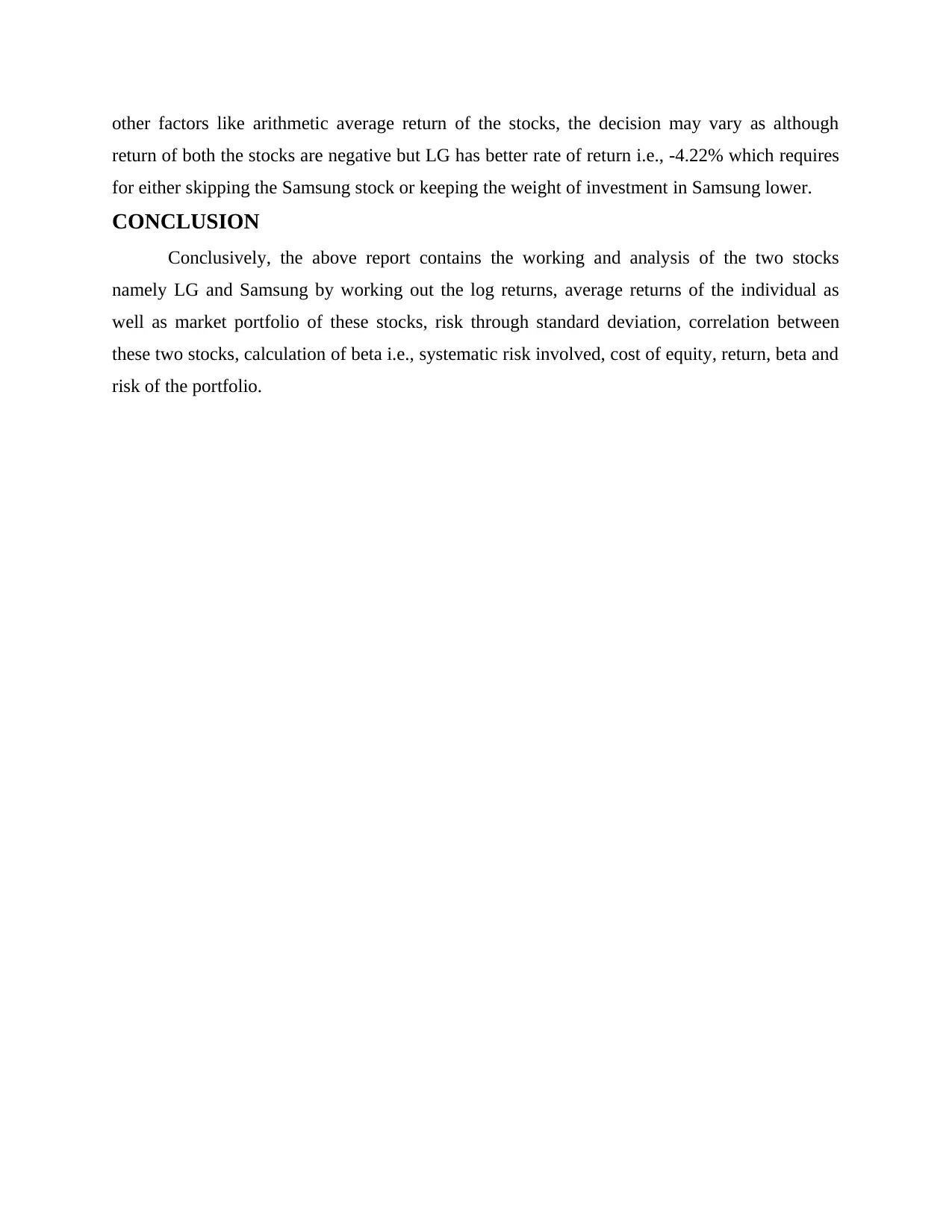
return of both the stocks are negative but LG has better rate of return i.e., -4.22% which requires
for either skipping the Samsung stock or keeping the weight of investment in Samsung lower.
CONCLUSION
Conclusively, the above report contains the working and analysis of the two stocks
namely LG and Samsung by working out the log returns, average returns of the individual as
well as market portfolio of these stocks, risk through standard deviation, correlation between
these two stocks, calculation of beta i.e., systematic risk involved, cost of equity, return, beta and
risk of the portfolio.
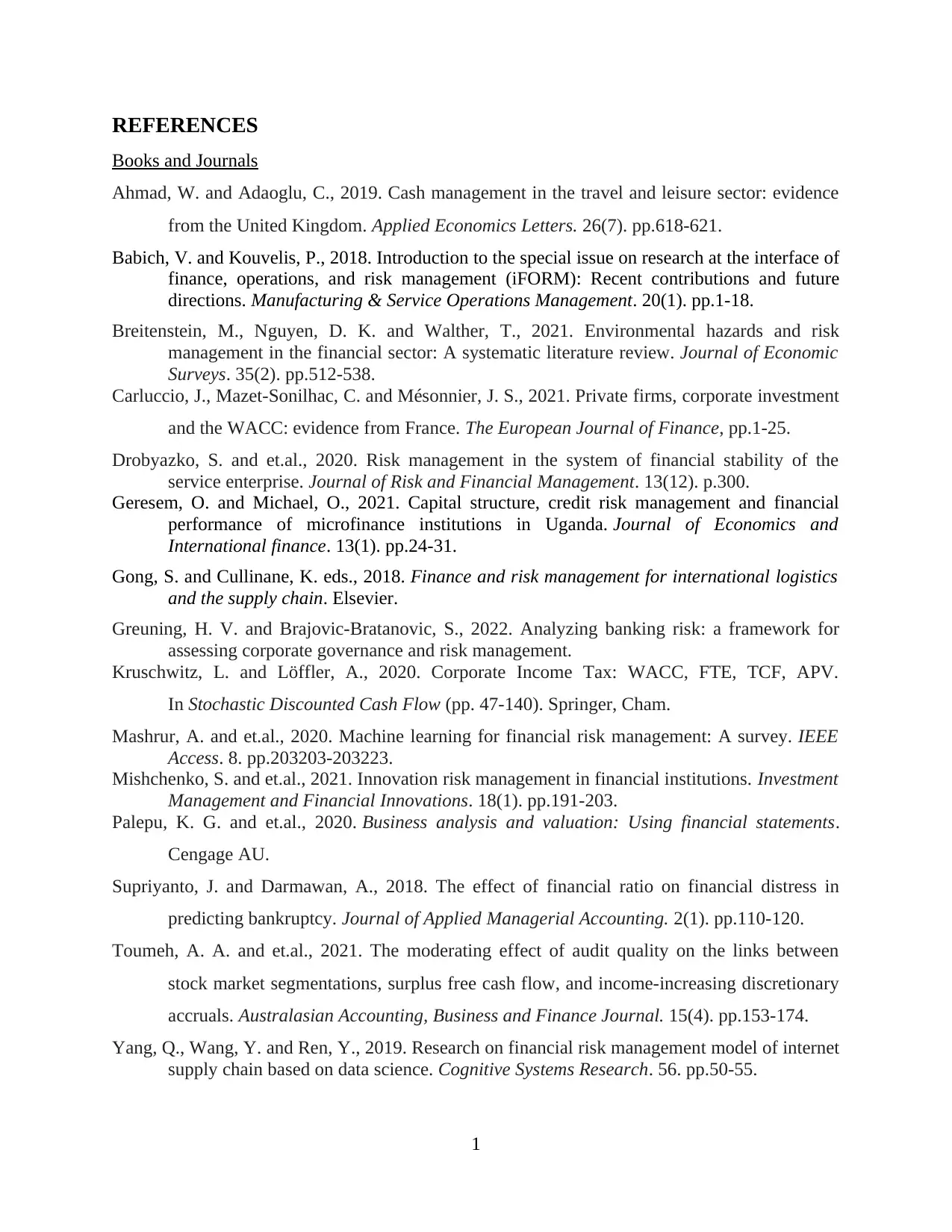
Books and Journals
Ahmad, W. and Adaoglu, C., 2019. Cash management in the travel and leisure sector: evidence
from the United Kingdom. Applied Economics Letters. 26(7). pp.618-621.
Babich, V. and Kouvelis, P., 2018. Introduction to the special issue on research at the interface of
finance, operations, and risk management (iFORM): Recent contributions and future
directions. Manufacturing & Service Operations Management. 20(1). pp.1-18.
Breitenstein, M., Nguyen, D. K. and Walther, T., 2021. Environmental hazards and risk
management in the financial sector: A systematic literature review. Journal of Economic
Surveys. 35(2). pp.512-538.
Carluccio, J., Mazet-Sonilhac, C. and Mésonnier, J. S., 2021. Private firms, corporate investment
and the WACC: evidence from France. The European Journal of Finance, pp.1-25.
Drobyazko, S. and et.al., 2020. Risk management in the system of financial stability of the
service enterprise. Journal of Risk and Financial Management. 13(12). p.300.
Geresem, O. and Michael, O., 2021. Capital structure, credit risk management and financial
performance of microfinance institutions in Uganda. Journal of Economics and
International finance. 13(1). pp.24-31.
Gong, S. and Cullinane, K. eds., 2018. Finance and risk management for international logistics
and the supply chain. Elsevier.
Greuning, H. V. and Brajovic-Bratanovic, S., 2022. Analyzing banking risk: a framework for
assessing corporate governance and risk management.
Kruschwitz, L. and Löffler, A., 2020. Corporate Income Tax: WACC, FTE, TCF, APV.
In Stochastic Discounted Cash Flow (pp. 47-140). Springer, Cham.
Mashrur, A. and et.al., 2020. Machine learning for financial risk management: A survey. IEEE
Access. 8. pp.203203-203223.
Mishchenko, S. and et.al., 2021. Innovation risk management in financial institutions. Investment
Management and Financial Innovations. 18(1). pp.191-203.
Palepu, K. G. and et.al., 2020. Business analysis and valuation: Using financial statements.
Cengage AU.
Supriyanto, J. and Darmawan, A., 2018. The effect of financial ratio on financial distress in
predicting bankruptcy. Journal of Applied Managerial Accounting. 2(1). pp.110-120.
Toumeh, A. A. and et.al., 2021. The moderating effect of audit quality on the links between
stock market segmentations, surplus free cash flow, and income-increasing discretionary
accruals. Australasian Accounting, Business and Finance Journal. 15(4). pp.153-174.
Yang, Q., Wang, Y. and Ren, Y., 2019. Research on financial risk management model of internet
supply chain based on data science. Cognitive Systems Research. 56. pp.50-55.
1
⊘ This is a preview!⊘
Do you want full access?
Subscribe today to unlock all pages.

Trusted by 1+ million students worldwide

performance. Copernican Journal of Finance & Accounting. 9(1). pp.77-100.
Online
Samsung Electronics Co. Ltd. 2022. [Online]. Available through: https://www.wsj.com/market-
data/quotes/SSNLF/financials
2
Related Documents
Your All-in-One AI-Powered Toolkit for Academic Success.
+13062052269
info@desklib.com
Available 24*7 on WhatsApp / Email
![[object Object]](/_next/static/media/star-bottom.7253800d.svg)
© 2024 | Zucol Services PVT LTD | All rights reserved.





